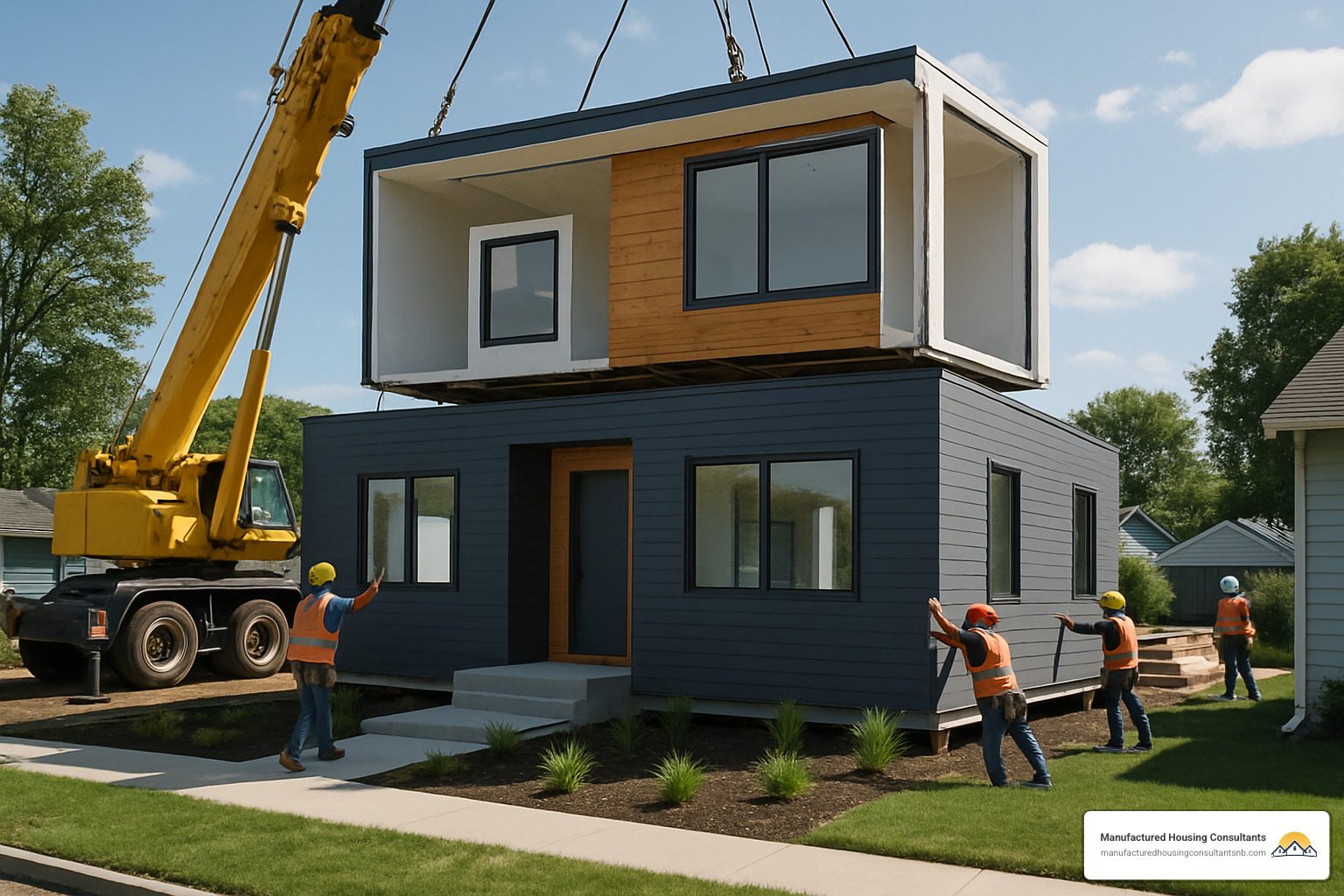The Best Affordable Prefab Houses on a Budget
Discover affordable prefab houses—compare costs, benefits, and tips to buy, build, and customize your budget-friendly dream home.
The Smart Solution to Rising Housing Costs
Affordable prefab houses are factory-built homes that offer quality construction at lower prices than traditional site-built homes. These homes are manufactured in controlled environments and then transported to your property for final assembly.
| Quick Facts: Affordable Prefab Houses |
|---|
| Price Range: $50,000-$200,000+ |
| Construction Time: 8 weeks to 9 months (vs. 12-24 months for traditional) |
| Types: Modular, panelized, kit, and manufactured homes |
| Size Options: From tiny homes (400 sq ft) to large family homes (2,400+ sq ft) |
| Energy Efficiency: Often exceeds traditional homes due to precision construction |
Are you tired of being priced out of the housing market? You’re not alone. With traditional home prices soaring across Texas and the nation, many budget-conscious buyers like you are finding that prefab and modular homes offer a practical path to homeownership.
These modern factory-built homes aren’t the mobile homes of decades past. Today’s prefab houses feature contemporary designs, quality materials, and can last up to 100 years with proper maintenance.
A key advantage is speed – prefab homes require 60% less framing time than site-built homes, and modular construction can accelerate project timelines by 30 to 50 percent. This translates directly to cost savings.
“The McMansion is as dead for many Americans as the fax machine,” notes one industry expert. Instead, today’s homebuyers are seeking right-sized, efficient spaces that meet their needs without excessive square footage or price tags.
Whether you’re looking for a compact starter home, a backyard ADU, or a spacious family dwelling, prefab options exist in virtually every size and style to match your budget and lifestyle needs.
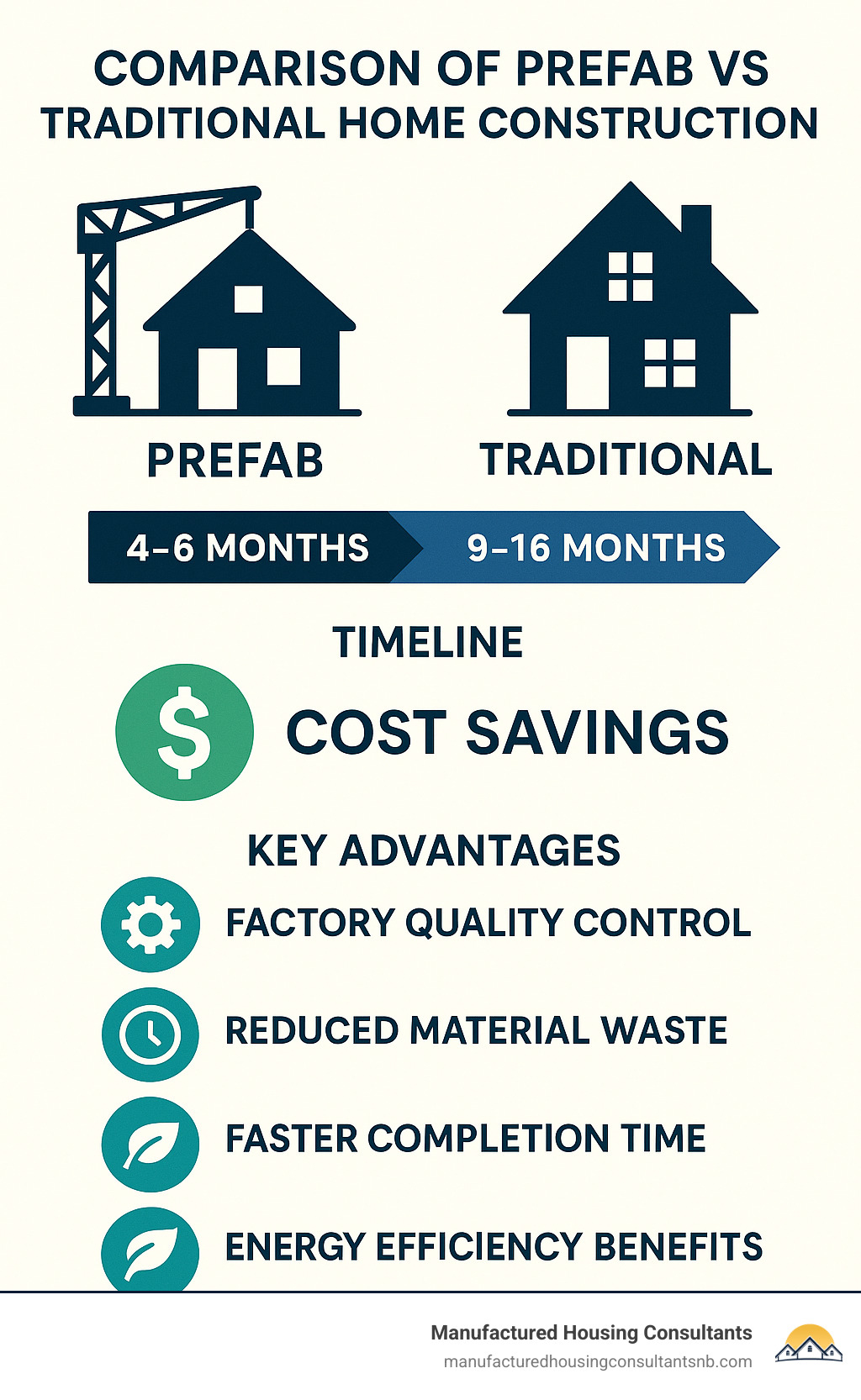
Affordable prefab houses word guide:
- affordable eco friendly modular homes
- cheap mobile trailer homes for sale
- cheap trailer house for sale
Affordable Prefab Houses: Cost, Benefits, and Buying Guide
When comparing affordable prefab houses to traditional site-built homes, the numbers tell a compelling story. If you’re like most homebuyers today, you’re looking for value without sacrificing quality—and that’s exactly where prefab construction shines.
| Factor | Prefab/Modular Homes | Traditional Site-Built Homes |
|---|---|---|
| Average Cost | $50,000-$200,000 ($90-$300 per sq ft) | $300,000-$500,000+ ($150-$400+ per sq ft) |
| Construction Time | 8 weeks to 9 months | 12-24 months |
| Labor Requirements | Factory-based, less affected by labor shortages | Requires multiple specialized contractors on-site |
| Material Waste | 5% or less | Up to 25% waste |
| Weather Delays | Minimal (indoor construction) | Significant impact on timeline |
| Quality Control | Consistent factory standards | Variable based on contractors |
| Energy Efficiency | Often exceeds code due to precision | Varies widely by builder |
The savings aren’t just nice—they’re substantial. Hard costs like land, materials, and labor typically eat up 65-73% of your budget in traditional construction. Prefab homes slash these costs through smart factory efficiencies.
I recently spoke with a customer who shared: “We were quoted $900,000 to $1.2 million for a 2,600 sq ft stick-built home. Our 1,700 sq ft modular home with a 9′ basement came in at around $400,000, plus $85,000 for the garage. We saved a small fortune and moved in months earlier!”
According to research from McKinsey, modular construction can reduce costs by 20-50% compared to traditional building methods. If you’d like to explore options that won’t break the bank, check out our guide to Affordable Modular Homes.
Prefab vs. Modular vs. Manufactured: What’s the Difference?
Let’s clear up some confusion—these terms aren’t interchangeable, though many people use them that way.
Prefabricated (Prefab) Homes is the umbrella term covering any home with factory-built components. Think of it as the family name for all these housing types.
Modular Homes are built in sections (or modules) in a factory, then assembled on your permanent foundation. Here’s what makes them special: they follow the same International Residential Code (IRC) as traditional homes. Your neighbors won’t even know the difference—except maybe how quickly your home appeared!
Manufactured Homes (formerly called mobile homes) are completely built in factories and transported on their own chassis. These follow federal HUD code rather than local building codes. They’re typically classified as personal property unless converted to real property through specific legal steps.
Panelized Homes involve factory-built panels (walls, floors, roof) that get assembled on-site. They offer more design flexibility but require more field work.
Kit Homes ship you pre-cut, pre-measured materials for assembly on your property. They require the most on-site work but give you maximum customization.
The National Institute of Standards and Technology offers detailed information about building codes that regulate these different housing types. At Manufactured Housing Consultants in New Braunfels, we offer varieties from all these categories through our partnerships with 11 top manufacturers.
Why Are Affordable Prefab Houses Cheaper?
The magic happens in the factory. Affordable prefab houses cost less for several practical reasons:
Factory Efficiency transforms homebuilding from a craft into a science. Workers specialize in specific tasks—becoming incredibly efficient at what they do. Imagine an assembly line for your home where every step is optimized.
Material Waste drops dramatically—from up to 25% on traditional sites to under 5% in factories. Every piece of lumber is precisely cut, every scrap is accounted for, and many materials are recycled back into production.
Weather Independence means no more rain delays or materials warping in humidity. Your home components stay dry and protected until assembly.
Bulk Purchasing Power lets manufacturers buy materials at wholesale prices that individual contractors simply can’t match. These savings get passed on to you.
Reduced On-Site Time with up to 60% less framing time means lower labor costs. And in today’s construction market with serious labor shortages, that’s a huge advantage.
Lower Permit Values often apply since about 80% of prefab homes are owner-built rather than speculative builds. This can mean lower fees and taxes in many jurisdictions.
Theft and Damage risks virtually disappear. Traditional sites lose thousands to stolen materials and weather damage—costs that inevitably find their way into your final price tag.
Key Advantages: Speed, Quality, Energy Savings
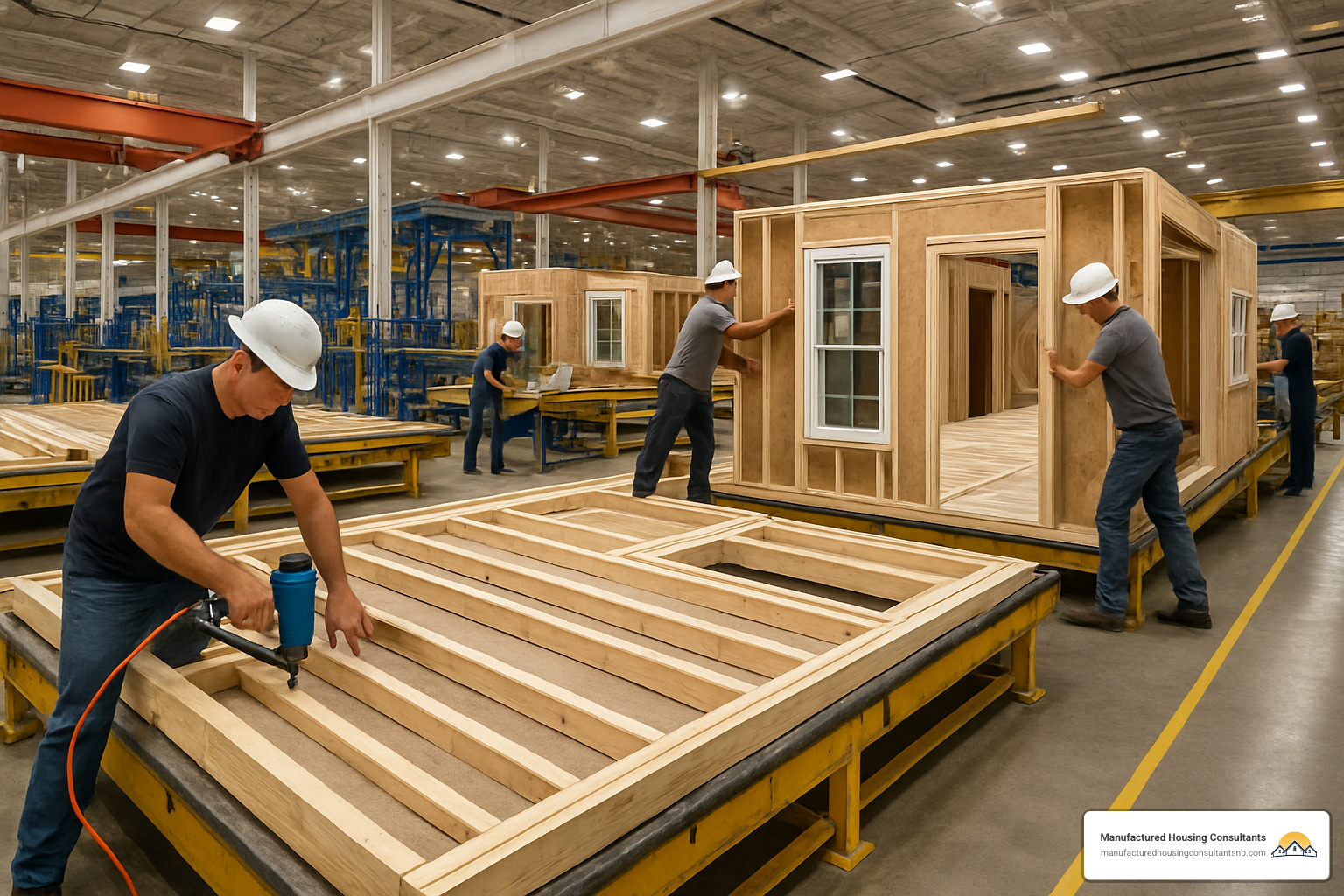
The benefits of affordable prefab houses go well beyond your wallet:
Speed of Construction might be the most immediately noticeable advantage. While your foundation is being prepared on-site, your home is simultaneously taking shape in the factory. This parallel process can shrink your timeline from a year-plus to just three months in many cases. For folks eager to move in (and stop paying rent or a second mortgage), this is priceless.
Superior Quality Control comes from building in a controlled environment. Each home undergoes multiple inspections during manufacturing. As one of our builders likes to say, “These homes are built to survive a highway trip at 60 mph—they’re solid.” The precision of factory settings ensures everything from wall studs to cabinet installations meets exacting standards.
Energy Efficiency is where many prefab homes truly shine. The precision of factory construction creates tighter building envelopes with better insulation. Many of our homes feature structural insulated panels with near-zero thermal bridging, factory-sealed joints that minimize air leakage, and energy-efficient windows installed with laser precision. Your utility bills will thank you.
Durability is impressive—properly built prefab homes can last up to 100 years with appropriate maintenance. Unlike traditional construction where materials sit exposed to the elements for months, factory components stay protected until assembly.
Sustainability isn’t just a buzzword with prefab construction. Less waste, recycled materials, and energy-efficient designs make these homes gentler on our planet. Some of our prefab models even meet Passive House standards, reducing energy consumption by up to 90%.
Resilience comes built-in. A FEMA study after Hurricane Andrew found that modular homes withstood wind and water better than most site-built homes in the area. The reinforced construction necessary for transportation often creates a stronger structure overall.
Hidden Costs to Budget For
While the base price of affordable prefab houses typically beats traditional construction, you’ll want to plan for these additional expenses:
Land Acquisition typically represents 10-20% of your total budget. Here in Texas, prices vary dramatically between rural areas and spots closer to San Antonio or Austin. We can help you find affordable land that works with your prefab home plans.
Site Preparation includes clearing, grading, soil testing, and possibly access road construction. Don’t forget utility connections—water, sewer, electricity, and gas need to reach your home site.
Foundation requirements depend on your home design and local soil conditions. Options range from simple concrete slabs to full basements. This is one area where cutting corners can be costly long-term.
Transportation costs depend on distance from the factory to your site. For larger homes requiring multiple modules, factor in oversized load permits and escort vehicles.
Crane and Assembly services set your modules in place—a fascinating process that transforms separate boxes into your cohesive home in just a day or two.
Interior Finishes may not be included in some prefab packages. Cabinets, countertops, flooring, and fixtures could be additional costs depending on your contract.
Landscaping and Exterior Features like driveways, patios, decks, and gardens complete your home but aren’t typically included in prefab packages.
At Manufactured Housing Consultants, we offer financing for modular homes and land improvement services to help manage these additional costs. We believe in transparent pricing—no surprises, just straightforward guidance through every step of your homebuying journey.
Planning, Customizing, and Building Your Prefab Home
Ready to start your journey to an affordable prefab house? Let’s walk through the steps together – it’s easier than you might think!
First, take some time to really consider what you need in a home. Many of us are realizing that thoughtfully designed smaller spaces not only cost less upfront but also save on utilities and maintenance for years to come. Set a realistic budget that includes both your must-haves and wish-list items.
Finding the right piece of land is crucial. When looking at potential properties in Texas, consider things like zoning regulations (some areas have restrictions on factory-built homes), utility access (is city water available or will you need a well?), and the land’s characteristics. Is it flat enough for easy foundation work, or will you need extensive grading? At Manufactured Housing Consultants, we often help customers evaluate these factors before they purchase.
“We spent months looking for land before talking to the team at Manufactured Housing Consultants,” shares Maria from San Antonio. “They pointed out considerations we hadn’t even thought about, like checking flood zones and septic requirements. It saved us from making a costly mistake!”
Once you’ve secured your land, it’s time for the fun part – choosing your design! Browse through manufacturer catalogs or work with our design team to find a modular home floor plan that fits your lifestyle. Whether you need a single-story layout for accessibility or a multi-bedroom home for a growing family, there’s a prefab solution waiting for you.
Financing is where many people feel intimidated, but we’re here to help. You might need a land loan, construction loan, or a specialized modular home financing package. Our team can walk you through the options and connect you with lenders who understand the prefab process.
After securing financing and permits (which vary by Texas county), site preparation begins while your home is simultaneously being built in the factory – this parallel process is one of the biggest time-savers with prefab construction! When both are ready, your home modules arrive and are assembled on your foundation, followed by finishing work and final inspections.
How Customizable Are Prefab Models?
Think prefab means cookie-cutter? Think again! Today’s affordable prefab houses offer impressive customization options that surprise many of our customers.
“I always thought prefab meant ‘what you see is what you get,'” says James from New Braunfels. “But we were able to move walls, upgrade finishes, and even raise ceiling heights. Our home feels completely custom-built.”
Floor plans can be adjusted to suit your needs – expand the kitchen, add a home office, or create an open-concept living area. Exterior options range from traditional vinyl siding to modern fiber cement, metal, or even wood. Choose your roof style, window placements, and add architectural details that make your home uniquely yours.
Inside, the options continue with various flooring materials, cabinet styles, countertop selections, and lighting fixtures. Many of our customers are particularly excited about integrating smart home technology like programmable thermostats, security systems, and energy monitoring.
Some of the most popular upgrades worth considering include:
- Energy-efficient packages with superior insulation and high-performance windows
- Solar-ready roofing for future panel installation
- Heat pump systems that reduce utility bills
- Built-in storage solutions that maximize space efficiency
- Water-saving fixtures that conserve resources and lower bills
- Accessibility features like wider doorways and zero-step entries
The beauty of working with Manufactured Housing Consultants is that we’ll help you understand which customizations give you the best value for your investment, whether you’re looking for luxury touches or practical improvements.
Timeline: Factory Floor to Move-in in 3–6 Months
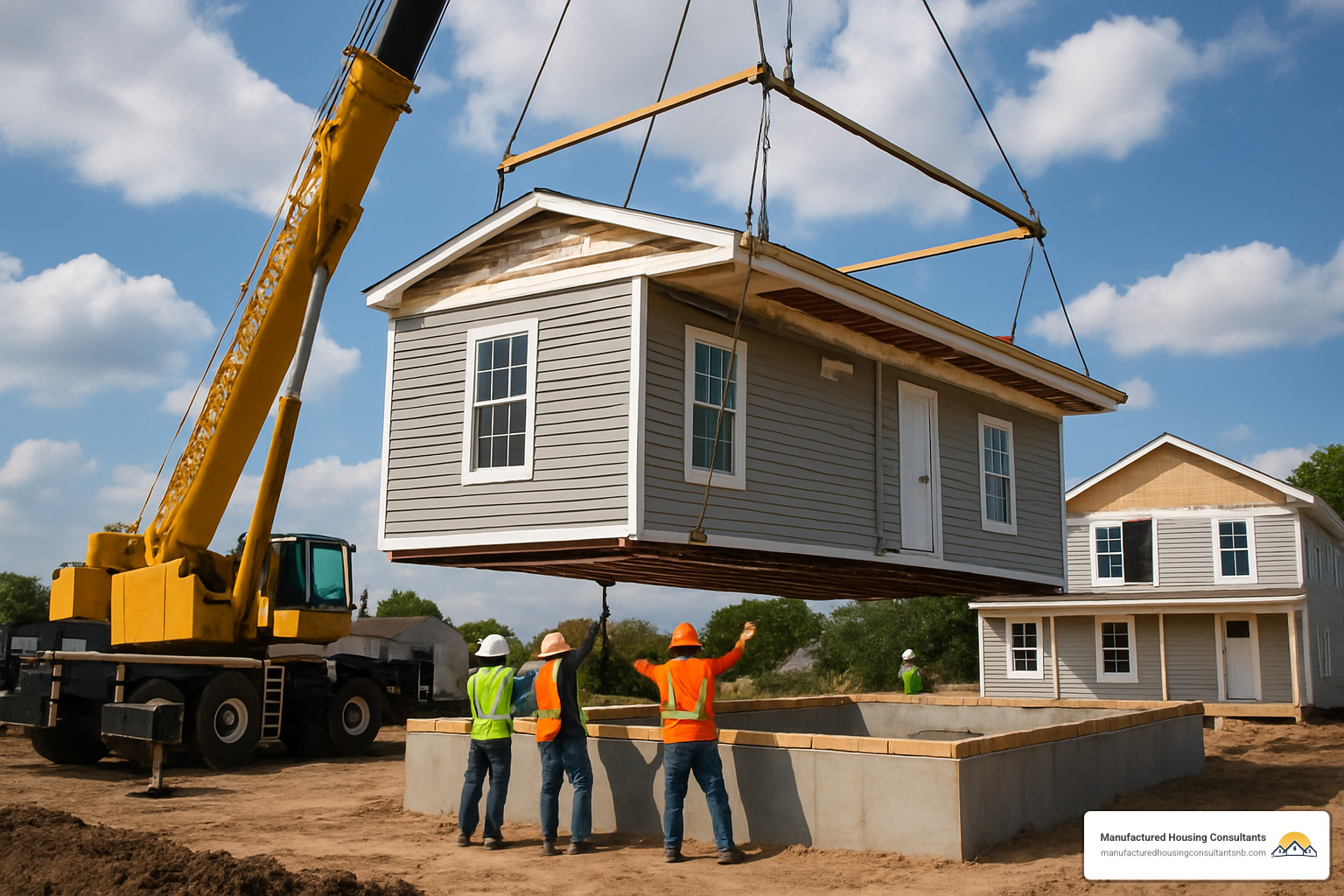
One of the most exciting aspects of choosing an affordable prefab house is the dramatically shortened timeline. While your traditional-building friends might be enduring a year or more of construction headaches, you could be unpacking boxes in your new home in just a few months!
The journey begins with the planning and permitting phase, which typically takes 1-3 months. During this time, you’ll finalize your design choices, secure financing, and work through the necessary permits. Don’t worry – we’ll guide you through the paperwork maze that often intimidates first-time builders.
Once plans are approved, the real magic happens. While your foundation is being poured and utilities are being connected at your site, your home is simultaneously being built in a climate-controlled factory. This parallel construction is the secret sauce that makes prefab so efficient.
“I still can’t believe how quickly everything came together,” shares Elena, a recent customer. “The factory built our entire home in just 6 weeks while our foundation was being prepared. It was like watching two pieces of a puzzle being created at the same time.”
The factory construction phase typically takes 4-12 weeks, depending on the complexity of your home. During this time, skilled workers complete everything from framing to installing fixtures in a precision-controlled environment – no weather delays, no missing materials, no subcontractor scheduling conflicts.
Then comes the most exciting day – set day! Your home modules arrive on specialized carriers and are carefully lifted into place by crane, usually in just one or two days. There’s nothing quite like seeing your home come together before your eyes in a matter of hours.
After the modules are secured and weathertight, the finishing work begins. This includes connecting utilities, completing interior seams where modules join, finalizing exterior details, and completing any site work like driveways or landscaping. This typically takes another 2-6 weeks before you’re ready for your final inspections and move-in day.
All told, many of our customers are enjoying their new homes within 3-6 months of starting the process – less than half the time of traditional construction.
Challenges: Financing, Zoning, Transportation
While affordable prefab houses offer tremendous advantages, it’s important to be aware of potential challenges so you can steer them successfully.
Finding the right financing can sometimes be tricky. Some lenders aren’t familiar with the prefab construction process and may have outdated perceptions about factory-built homes. You might encounter appraisal issues due to limited comparable sales in your area, or face higher down payment requirements. At Manufactured Housing Consultants, we maintain relationships with lenders who understand the value and process of prefab construction, making this hurdle much easier to clear.
Zoning and regulations can also present obstacles. Some Texas communities or homeowners associations have restrictions on factory-built homes based on outdated stereotypes. Building inspectors may be unfamiliar with modular construction methods, leading to confusion during inspections. We help our customers research these issues before purchasing land and can provide documentation and education to local officials when needed.
Transportation logistics present another consideration. Your modules need to travel from factory to building site, which means size limitations based on road regulations. Difficult site access – like narrow rural roads or steep driveways – might complicate delivery. And the farther your site is from the factory, the higher your transportation costs will be.
Many customers worry about resale value, but this concern is largely unfounded. Modern prefab homes appreciate similarly to site-built homes of comparable quality in the same neighborhood. In fact, the calculation of modular home resale value often shows strong returns due to their energy efficiency and quality construction.
“We were initially concerned about resale,” admits Michael from San Marcos. “But our modular home has appreciated just as much as our neighbor’s traditional home – and we paid 30% less initially and have lower energy bills every month.”
Affordable Prefab Houses and the Housing Crisis
The housing shortage in America has reached critical levels, with an estimated deficit of 3.8 million units nationwide. Affordable prefab houses are emerging as a promising solution to this growing crisis.
Several factors have contributed to the current situation: skyrocketing construction costs, severe labor shortages in the building trades, lengthy development timelines due to regulatory problems, and restrictive land use policies that limit housing density. Meanwhile, population growth continues, creating even more demand for affordable homes.
Prefab construction directly addresses many of these challenges. By reducing construction time by 30-50%, manufacturers can deliver more homes more quickly. The factory setting requires fewer workers per home and uses their skills more efficiently, helping offset the labor shortage. Standardized production methods lower costs while maintaining consistent quality.
Policy makers have begun to take notice. We’re seeing expanded tax-exempt bond financing for affordable modular projects, efforts to standardize building codes across jurisdictions, and workforce development programs specifically for modular manufacturing. These initiatives are helping to scale up production capacity across the country.
Different regions are adopting prefab solutions in ways that address their specific needs. Urban areas are using modular construction for infill development and accessory dwelling units (ADUs). Rural communities like those surrounding New Braunfels are leveraging prefab to address housing shortages without long construction timelines. And areas prone to natural disasters are employing rapid-deployment modular housing for recovery efforts.
The multifamily sector shows particular promise. Traditional apartment buildings typically take more than 20 months to complete, while comparable modular projects can be finished in about 8 months. This acceleration directly translates to more available housing units in less time – exactly what we need to address the current shortage.
According to research from the American Progress, “Modular construction has many potential benefits, including cost savings, shorter development timelines, and an overall safer and more efficient development process.”
Regional Hotspots and Real-World Price Examples
Affordable prefab houses vary in popularity and pricing across different regions, with some areas embracing factory-built homes more enthusiastically than others.
Here in Texas, our home base, we’ve seen tremendous growth in prefab popularity. The Texas climate makes factory construction especially advantageous – no rain delays, no materials warping in humidity, and no workers suffering in 100-degree heat. At Manufactured Housing Consultants in New Braunfels, we offer a wide range of affordable modular homes in Texas to meet this growing demand.
Texans can typically expect to pay $50,000-$90,000 for single-wide manufactured homes ranging from 400-1,330 square feet. Double-wide manufactured homes offering 1,100-2,400 square feet generally run $90,000-$150,000. For custom modular homes, prices typically range from $90-$150 per square foot (plus land and site work costs).
“We were paying $2,200 a month in rent for a two-bedroom apartment,” shares Thomas from San Antonio. “Now we own a three-bedroom manufactured home on an acre of land with a monthly payment of $1,100. The math just made sense.”
The Pacific Northwest has acceptd sustainable prefab options, with many manufacturers focusing on energy efficiency and modern design. EcoMod 2.0 homes (2,500 sq ft) run around $190 per square foot, while smaller Ideabox models range from $90,000-$150,000 for 400-800 square foot units.
In the Northeast, where labor costs are higher and building seasons shorter, prefab adoption has been strong. Ecocor Passive Houses command $200-$300 per square foot but offer extraordinary energy efficiency that can nearly eliminate heating bills. More moderate options like GO Home by GO Logic run $160-$200 per square foot.
Looking internationally provides perspective on where the industry is heading. European models like the compact Scandi Camp (40 m²) can be found for under €50,000, while the EestiHouse H66 and Unomod 55 offer larger footprints for under €100,000.
For those seeking ultra-affordable solutions, innovative options include tiny prefab units starting around $29,000 and the popular Boxabl Casita, which offers 361 square feet of well-designed space for approximately $50,000.
These examples demonstrate the remarkable range of affordable prefab houses available across different price points. The key is finding the right balance of size, features, and quality for your specific needs and budget – something we specialize in at Manufactured Housing Consultants.
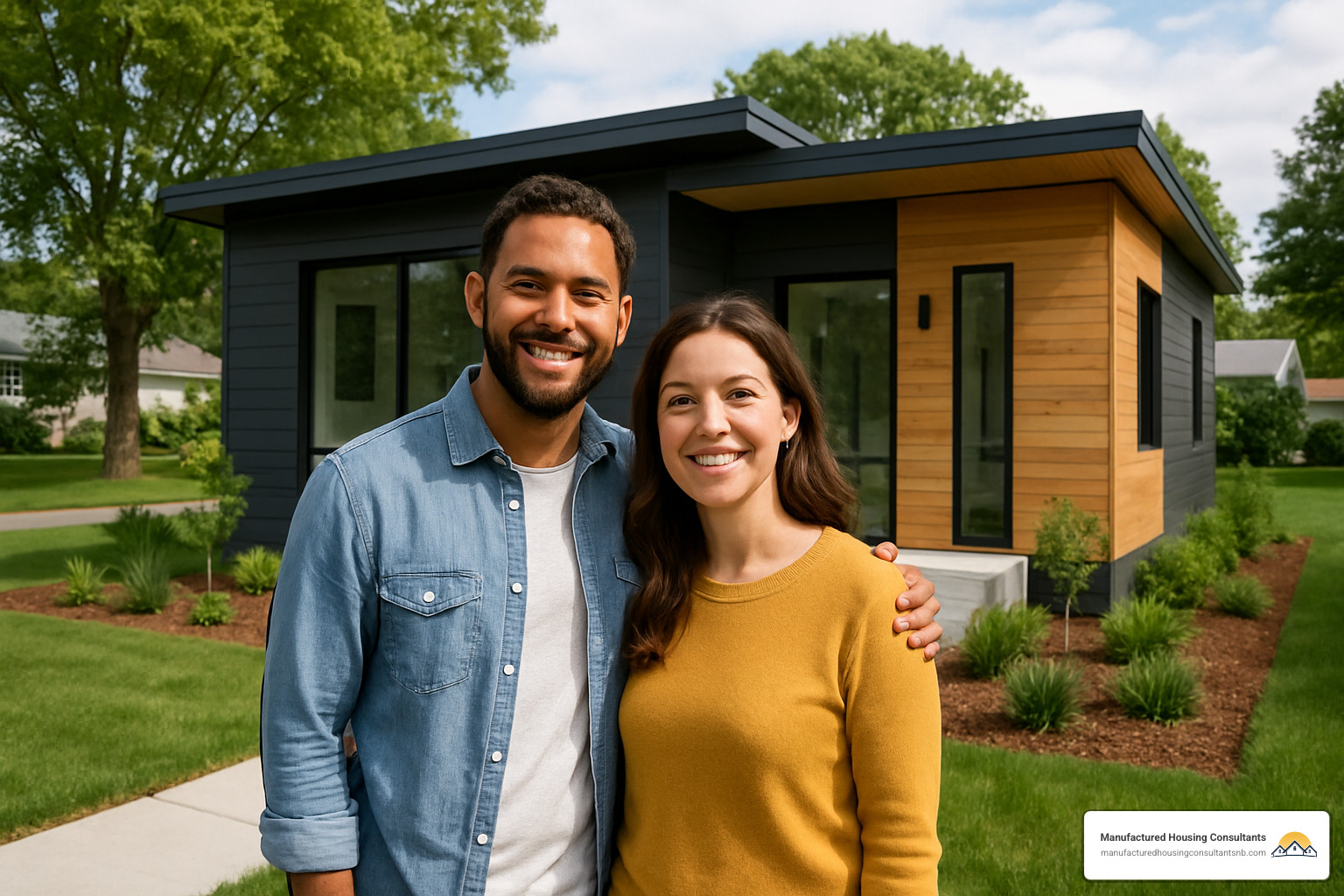
Conclusion & Next Steps
Affordable prefab houses represent a smart solution to today’s housing challenges, offering quality construction at lower costs and with faster timelines than traditional building methods. From compact tiny homes to spacious family dwellings, the prefab industry continues to innovate and expand options for budget-conscious homebuyers.
Key takeaways from our exploration:
-
Cost Efficiency: Factory production reduces waste, labor costs, and construction time, translating to savings for homebuyers.
-
Quality Construction: Controlled factory environments often produce homes with better precision and durability than site-built alternatives.
-
Speed Advantage: From contract to move-in, prefab homes can be completed in 3-6 months, compared to 12-24 months for traditional construction.
-
Design Flexibility: Today’s prefab homes offer extensive customization options to match your lifestyle and aesthetic preferences.
-
Sustainability: Energy-efficient designs and reduced construction waste make prefab an environmentally responsible choice.
If you’re ready to explore affordable prefab houses for yourself, Manufactured Housing Consultants in New Braunfels, Texas, is here to help. As a dealer representing 11 top manufacturers, we guarantee the lowest prices and offer a wide selection to meet diverse needs and budgets.
Our one-stop approach simplifies the process with:
- Comprehensive home selection assistance
- Land improvement services
- Financing options custom to prefab construction
- Expert guidance through permitting and installation
We understand that buying a home is one of life’s biggest investments, and we’re committed to making your journey to prefab homeownership as smooth as possible. Our team has helped countless Texas families find their perfect affordable housing solution.
Ready to learn more about our homes and how we can help you achieve your homeownership dreams? Contact Manufactured Housing Consultants today to schedule a consultation and take the first step toward your new prefab home.
The future of housing is here – factory-built, affordable, sustainable, and ready for you to move in sooner than you might think.

